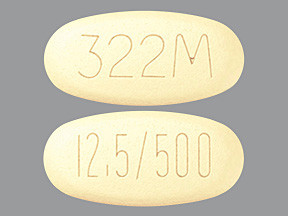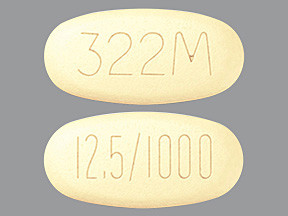ALOGLIPTIN/METFORMIN - ORAL
PHONETIC PRONUNCIATION: (AL-oh-GLIP-tin/met-FOR-min)
COMMON BRAND NAME(S): Kazano
GENERIC NAME(S): alogliptin benzoate/metformin HCl
Uses
USES: This combination medication is used with a proper diet and exercise program to control high blood sugar in people with type 2 diabetes. Controlling high blood sugar helps prevent kidney damage, blindness, nerve problems, loss of limbs, and sexual function problems. Proper control of diabetes may also lessen your risk of a heart attack or stroke. This product contains 2 medications: alogliptin and metformin. Alogliptin works by increasing levels of natural substances called incretins. Incretins help to control blood sugar by increasing insulin release, especially after a meal. They also decrease the amount of sugar your liver makes. Metformin works by helping to restore your body's proper response to the insulin you naturally produce. It also decreases the amount of sugar that your liver makes and that your stomach/intestines absorb.
How to use ALOGLIPTIN/METFORMIN - ORAL
HOW TO USE: Read the Medication Guide provided by your pharmacist before you start using alogliptin/metformin and each time you get a refill. If you have any questions, ask your doctor or pharmacist. Take this medication by mouth as directed by your doctor, usually twice a day with meals. Drink plenty of fluids while taking this medication unless otherwise directed by your doctor. The manufacturer directs not to split, break, or cut the tablet before taking it. However, many similar drugs (immediate-release tablets) can be split, broken, or cut. Follow your doctor's directions on how to take this medication. The dosage is based on your medical condition, response to treatment, and other medications you may be taking. Be sure to tell your doctor and pharmacist about all the products you use (including prescription drugs, nonprescription drugs, and herbal products). To reduce your risk of side effects (such as upset stomach), your doctor may direct you to start this medication at a low dose and gradually increase your dose. Take this medication regularly to get the most benefit from it. To help you remember, take it at the same times each day. Carefully follow your diabetes management plan, including medications, diet, and exercise. Check your blood sugar regularly as directed by your doctor. Keep track of the results, and share them with your doctor. Tell your doctor if your blood sugar measurements are often too high or too low. Your doctor may need to adjust your diabetes medication, exercise program, or diet.
Side Effects
Precautions
Interactions
Overdose
Images

- color
- pale yellow
- shape
- oblong
- imprint
- 12.5/500, 322M

- color
- pale yellow
- shape
- oblong
- imprint
- 12.5/1000, 322M

- color
- pale yellow
- shape
- oblong
- imprint
- 12.5/500, 322M

- color
- pale yellow
- shape
- oblong
- imprint
- 12.5/1000, 322M
Reviews
Faq for ALOGLIPTIN/METFORMIN - ORAL
Alogliptin/Metformin is an oral medication that combines two drugs, alogliptin and metformin. It is used to treat type 2 diabetes.
Alogliptin/Metformin works by lowering blood sugar levels in patients with type 2 diabetes. Alogliptin helps to increase the levels of insulin produced by the body after meals, while metformin helps to decrease the amount of glucose produced by the liver.
Common side effects of Alogliptin/Metformin may include diarrhea, nausea, vomiting, stomach upset, headache, and cold-like symptoms. These side effects are usually mild and go away on their own.
Alogliptin/Metformin should be taken as directed by your doctor. Typically, it is taken orally twice a day with meals to reduce the risk of stomach upset. Do not crush, chew, or break the tablets. Follow your doctor's instructions for the correct dosage and duration of treatment.
Alogliptin/Metformin can be used as a standalone treatment for type 2 diabetes or in combination with other diabetes medications such as insulin or sulfonylureas. Your doctor will decide the most appropriate treatment plan based on your individual needs.
Before taking Alogliptin/Metformin, inform your doctor if you have any kidney or liver problems, heart disease, pancreatitis, or a history of allergic reactions to any medications. It is important to monitor your blood sugar regularly and attend regular check-ups with your doctor while taking this medication.
Alogliptin/Metformin may cause low blood sugar levels, especially when used in combination with other diabetes medications or insulin. It is important to be aware of the symptoms of low blood sugar and take necessary precautions, such as carrying a source of sugar (e.g., glucose tabs, fruit juice) with you at all times.
It is generally recommended to limit alcohol consumption while taking Alogliptin/Metformin. Alcohol can affect blood sugar control and increase the risk of side effects such as lactic acidosis, especially if you have liver or kidney problems.
If you forget to take a dose of Alogliptin/Metformin, take it as soon as you remember. However, if it is close to the next scheduled dose, skip the missed dose and resume your regular dosing schedule. Do not double the dose to catch up.
Warning
WARNING: Rarely, too much metformin can build up in the body and cause a serious (sometimes fatal) condition called lactic acidosis. Lactic acidosis is more likely if you are an older adult, if you have kidney or liver disease, dehydration, heart failure, heavy alcohol use, if you have surgery, if you have X-ray or scanning procedures that use iodinated contrast, or if you are using certain drugs. For some conditions, your doctor may tell you to stop taking this medication for a short time. Ask your doctor or pharmacist for more details. Stop taking this medication and get medical help right away if you have any symptoms of lactic acidosis, such as unusual tiredness, dizziness, severe drowsiness, chills, blue/cold skin, muscle pain, fast/difficult breathing, slow/irregular heartbeat, or stomach pain with nausea/vomiting/diarrhea.
Disclaimer
IMPORTANT: HOW TO USE THIS INFORMATION: This is a summary and does NOT have all possible information about this product. This information does not assure that this product is safe, effective, or appropriate for you. This information is not individual medical advice and does not substitute for the advice of your health care professional. Always ask your health care professional for complete information about this product and your specific health needs.
No Reviews Yet